경기문화재단
Michael van Ofen, Painting as Meta-painting
Gyeonggi Museum of Modern art
This catalogue is published in conjunction with 2017-2018 Korea–Germany Contemporary Art Exchange Exhibition Irony & Idealism. It documents all exhibitions and artworks at 3 venues in Korea and Germany-Gyeonggi Museum of Modern Art, KF Gallery and Kunsthalle Münster-from September 2017 until September 2018.
|
Mun Hyejin critic, translator and art historian
Artist & Artwork - Michael van Ofen
“Some pictures of mine happen to look like abstract works of art. In fact, though, they are just results of a figurative line of development reaching far out into the abstract.”1
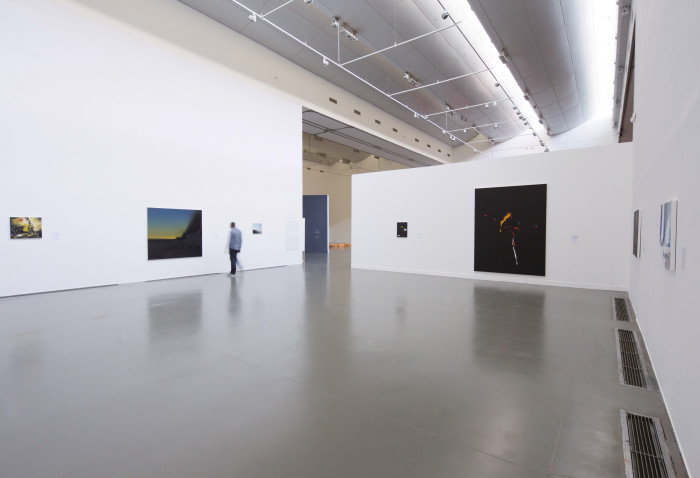
Michael van Ofen’s paintings seem to be abstract
paintings on the surface in many cases. It is not surprising
since most of van Ofen’s work is composed of
intermittent color fields without concrete figures and
created by a few brush strokes. Although there are
varying degrees of details, most of van Ofen’s paintings
omit details and partially depict figures while the
background mostly depicts light and shade. Without
the caption attached to the painting, it is not easy to
assume that a picture composed of three dots in beige,
light blue, and gray is a portrait. (Bismarck (2008)) A
simplified color field, composed of a black plane that
horizontally divides the canvas and light blue-gray, is
also difficult to realize that it appropriates the landscape
with mist. (Untitled (Nebel), (2007))
With regards to how van Ofen’s paintings look and how they employ the method of elimination, the artist’s works resemble the abstract art by the 20th-century modernists such as Malevich or Ad Reinhardt that wanted to eliminate concreteness and advance to the abstract world beyond the mundane reality. However, the artist’s painting is different from the abstract art from those modernist abstractionists. The concept of absolute abstraction is far from the artistic orientation of Michael van Ofen. The artist tells that practicing the absolute abstract art shall deprive of credible criteria of inspection, control, and modification, which will make him incomprehensible of where to start and where to stop.2 This lets us know that the beginning and end of van Ofen’s work are thoroughly based on the figurative practice.
All of van Ofen’s work depart from the figurative paintings from the past. Among them, the genre paintings from the 19th century (portrait, landscape, folk painting) are the source of the artist’s inspiration. Instead of choosing known masterpieces that have become the classics in the art history, he chooses stereotypical paintings that have almost become clichés with fixed techniques by genre painters. The reason seems to be that the artist’s subjects are not the painting styles of old masters or the symbolic value of masterpieces but the figurative painting in general. Indeed, the way van Ofen transforms the original treats all paintings as ‘found objects’ regardless of the artistic styles of the original paintings. (The degree or condition of transformation is unrelated to the original. Rather, it depends more on the artist’s intention or artistic focus.)

In is unclear why van Ofen took an interest in the figurative painting. However, the fact that the artist had studied photography with Thomas Struth and Andreas Gursky at Kunstakademie Düsseldorf before he turned to painting implies a meaningful point. When photography emerged in the 19th century, painting handed most of its initiative in representational art over to photography. The domain that had been previously occupied by genre paintings such as portrait or landscape disappeared. Different from photography that is figurative and representational by default, painting starts from the abstract state (empty canvas and paints) and artificially constructs figures. It might be that the artist was fascinated by painting’s features that were distinct from those of photography and started exploring how the figurative is created in painting. Van Ofen’s painting examines the basic techniques of depicting objects and space and traces the concept of the figurative on a fundamental level. In this sense, the artist’s paintings are both figurative and non-figurative at the same time. They are figurative in a sense that they originate from figurative paintings from the past and experiment techniques of creating figures. However, they do not intend to represent figures. Rather, they raise fundamental questions about painting. Van Ofen’s questions concern what is painterly and how the figurative can be constructed by painting. As such, the artist’s paintings pose a certain sense of distance toward figurative paintings although they start from the 19th-century representational paintings.
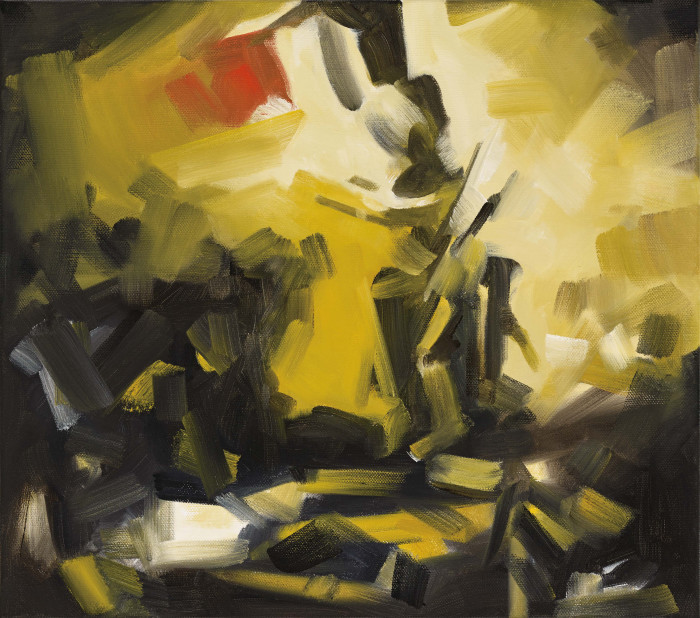
Replication after Eugene Delacroix
Let’s start from Nach E.D.(2016), one of van Ofen’s works exhibited at the exhibition Irony & Idealism (Gyeonggi Museum of Modern Art, 2017), which is among the easiest of the artist’s works to assume the original reference. One can realize that Nach E.D. not only mimics a certain figurative painting but also references a well-known painting La Liberté guidant le people by Eugène Delacroix from two elements of the picture. One is the title of the work and the other is the composition of colors, light, and brush strokes that remind of the original reference. Although the title only mentions initials of Eugène Delacroix, the viewers can easily recognize Delacroix’s name since the original reference is so well-known. At this point, the format of the work, which extracts the characteristics its reference, supports the identity of the original reference. The composition of colored masses corresponds to Delacroix’s original painting, light and shade roughly coincide, and postures and movements of characters are also reflected in the brush stroke. For example, the part behind the goddess of liberty and the chest of a corpse in the lower left of the image – which are the brightest parts of the original – are painted white in van Ofen’s rendition of Delacroix’s original work. In addition, the posture of the goddess that raises her right arm and stretches her left leg and the outline of the crowd are expressed through the direction of brush strokes.
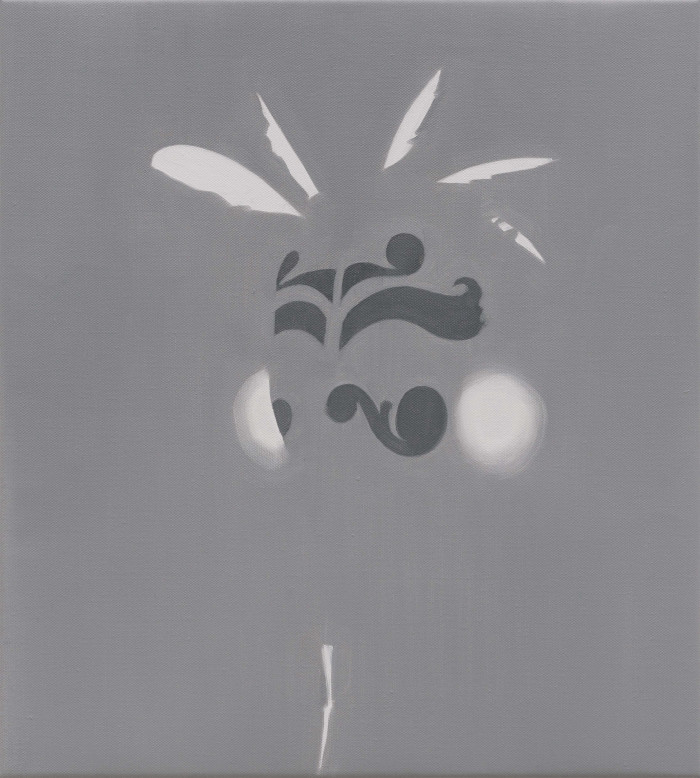
The Symbolic Extension of the Self from the Prospect of the Early Contemporaries. Tattoo and Appliqué in: William Hodges, Portrait of a Maori Chieftain, 1773
The method of suggesting figures with a minimal number of elements appears more obviously in The Symbolic Extension of the Self, a series where the artist takes a further step in the technique of elimination and omission. The Symbolic Extension of the Self from the Prospect of the Early Contemporaries. Tattoo and Appliqué in: William Hodges, Portrait of a Maori Chieftain, 1773 (2016), a work with a rather lengthy title, is composed of graphic patterns in white and gray. What is interesting about the work is that details that represent the figure (eyes, nose, and mouth) are totally deleted. Instead, the artist only selects ornaments that symbolize the chieftain (decorative feathers and facial tattoos). The title of the work and the resulting image tell what figures the artist has eliminated with what kind of criteria. In the work, van Ofen focuses not on the appearance of the subject nor the style of portrait painting but indicators that represent the status (identity) of the depicted subject. He interprets such props as tools to symbolically extend one’s self.
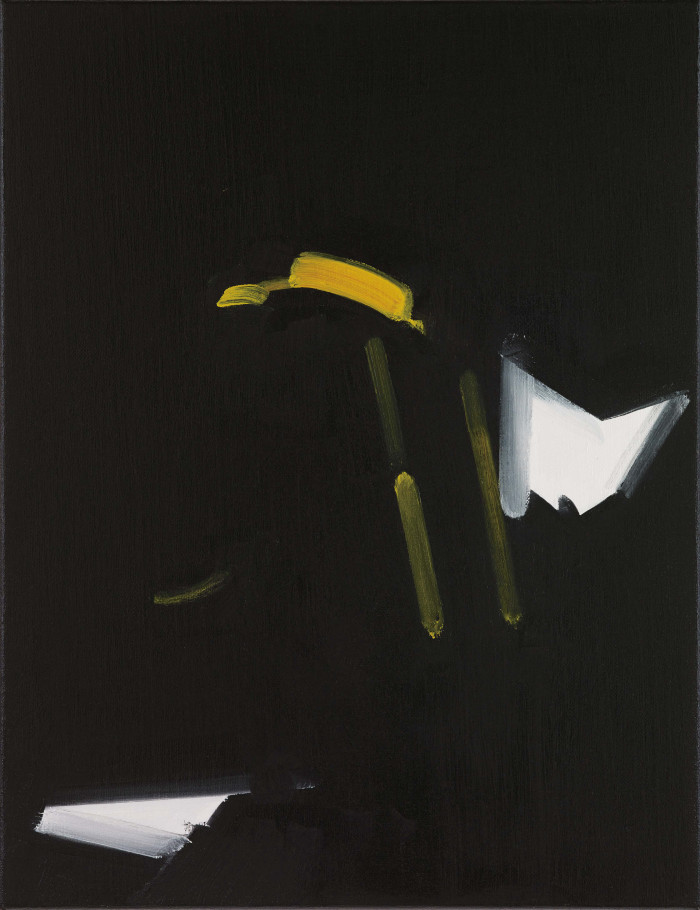
Authority and Regalia, Fürst Bismarck am Bundesratstisch, Anton von Werner, 155×115, Oil on Canvas, 1888
Van Ofen casts the original reference in a new way by interpreting 19th-century portraits in a semiotic manner. Such a methodology is clearly seen in a series where the artist reinterprets paintings by a German artist Anton von Werner(1843-1915). The series precedes the series mentioned before with regards to the implication of the artist’s criteria of selecting subjects through titles of his works. In Authority and Regalia: Fürst Bismarck am Bundesratstisch, 1888 (2013), the artist focused on symbols that represent authority. In the picture where all the biological properties have been eliminated, what remains are the yellow collar and golden buttons that represent the authority of chancellor Bismarck and papers that are the medium that conveys his authority. In Linear Emphasis of the Subject in: Die Eroeffnung des Reichstags im Weissen Saal des Berliner Schlosses durch Wilhelm II., 1893(2014), detailed information that indicates specific space and time is completely deleted, only leaving decorative ribbons and stripes of military dress uniforms. While observing the process where representation transforms into abstraction by processing keywords related to authority, the viewers are led to think about how to read the picture and what is the meaning of figurative representation.
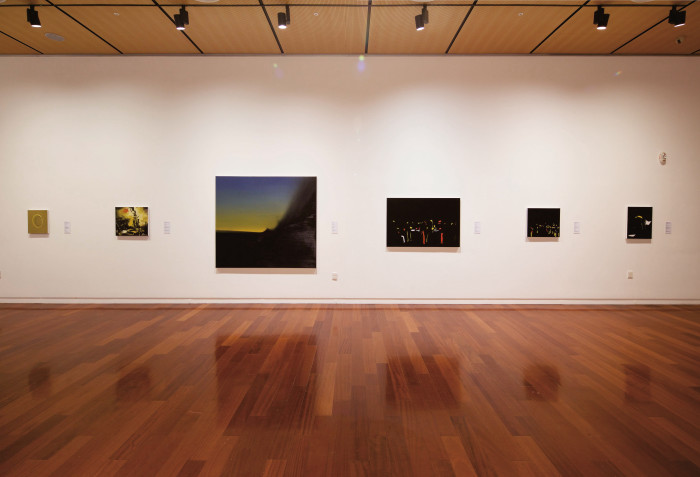

Van Ofen’s paintings eliminate concrete figures in them. However, they maintain the structure of figurative paintings they reference with regards to the organization of colors and light and shade. In this sense, they oscillate on the boundary between the figurative and the abstract, raising questions about the essence of the two modes of representation. In van Ofen’s intermediate paintings, a linear abstraction represents stripes on trousers while three dots serve as the head and hands of a figure. It is the one who reads van Ofen’s paintings that administers them as being figurative or abstract. Van Ofen’s paintings questions about the essence of painting in the twilight of painting. In this sense, the artist’s paintings are paintings about painting. Van Ofen’s works ceaselessly investigate how painting constructs the figurative. They quietly prove the manner of the artist’s paintings as meta-paintings.

1. Quoted from Jens Hoffmann, “What Painting, And Painting, and Can Only Do,” Michael Van Ofen (Berlin: DISTANZ Verlag, 2011), p. 79
2. ibid.
<ggc의 모든 콘텐츠는 저작권법의 보호를 받습니다.>
세부정보
IRONY & IDEALISM
Publisher/ Sul Wonki
Chief Editor/ Choi Eunju
First Edition/ July 31. 2018
Published by/ Gyeonggi Museum of Modern Art
List of Artists/ Ahn Jisan, Bae Young-whan, Björn Dahlem, Gimhongsok, Hwayeon Nam, Michael van Ofen, Manfred Pernice, Yoon Jongsuk